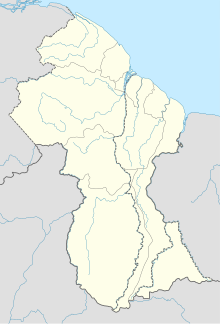Omai Mine
| Location | |
|---|---|
| Cuyuni-Mazaruni | |
| Country | Guyana |
| Coordinates | 5°25′48″N 58°45′47″W / 5.430°N 58.763°W |
| Production | |
| Products | Gold |
The Omai mine is one of the largest gold mines in Guyana. The mine is located in the north-west of the country in Cuyuni-Mazaruni. The mine has estimated reserves of 3.7 million oz of gold.
Geology
Geologically the Omai deposit has an orogenic style of gold mineralisation and is a slightly younger (Paleoproterozoic) analogue for similar Archean-aged deposits found in other cratonic areas worldwide such as the Canadian Shield. The deposit is split into two related zones: the Wenot zone hosted by saprolitised felsic units that run parallel to a regional tectonic structure, and the Fennell zone which is found within a nearby carrot-shaped granitoid plug. The free gold is contained within narrow horizontal quartz-scheelite veins.
The twin Wenot and Fennell deposits were mined from 1993 to 2006, concurrently from surface in open pits. Additional gold ore is likely to remain beneath the Fennell pit and along strike from the Wenot zone. Local prospectors, known as pork-knockers have historically worked the saprolite in the mine area for nuggets of gold.
Environmental Incident
On 19 August 1995 a tailings dam broke and leaked tailings into the Essequibo River. 4.2 million cubic metres of cyanide-containing slurry escaped. Eighty kilometres of the Essequibo River were declared an environmental disaster zone. Large numbers of fish were killed.[1] Production at the mine was halted for several months while the spill was investigated. The principal mine owners were Cambior Inc., based in Canada; Golden Star Resources Inc, based in Colorado, USA; and the government of Guyana. Cambior owned 65%, and Golden Star 30%, of the mine. Attempts were made in Guyana and in Canada to sue the companies. The Guyana case sought $2 billion in damages. These cases were dismissed in Canada in 1998, and in Guyana in 2002 and 2006.[2]
The environmental alert on the river was lifted after one week, but Indigenous villagers on the river were still using alternative water sources, at considerable inconvenience, seven years after the spill.[3]
According to a 2002 article in Geotechnical News, the dilute contaminant could not have caused all of the alleged environmental effects.[4]
See also
References
- ^ Mineral Policy Institute, "Chronology of Major Tailings Dam Failures" http://www.mpi.org.au/2014/08/chronology-of-major-tailings-dam-failures/ mpi.org] Accessed June 2018.
- ^ Environmental Justice Atlas https://ejatlas.org/conflict/omai-gold-mine-tailings-dam-guyana
- ^ McGill Research Group Investigating Canadian Mining in Latin America, "Omai, Guyana"
- ^ "This event caused debatable environmental damage with reports of downstream devastation far outstripping the ability of the dilute contamination to ever accomplish." -- Michael P Davies, "Tailings Impoundment Failures: Are Geotechnical Engineers Listening?" Geotechnical News, September 2002. http://www.pebblescience.org/pdfs/Dam_failuresDavies2002.pdf
External links
- S. Vick, R Squires and others, "Preliminary Report on Technical Causation Omai Tailings Dam Failure" (1995). http://wise-uranium.org/mdgr.html Accessed June 2018.

